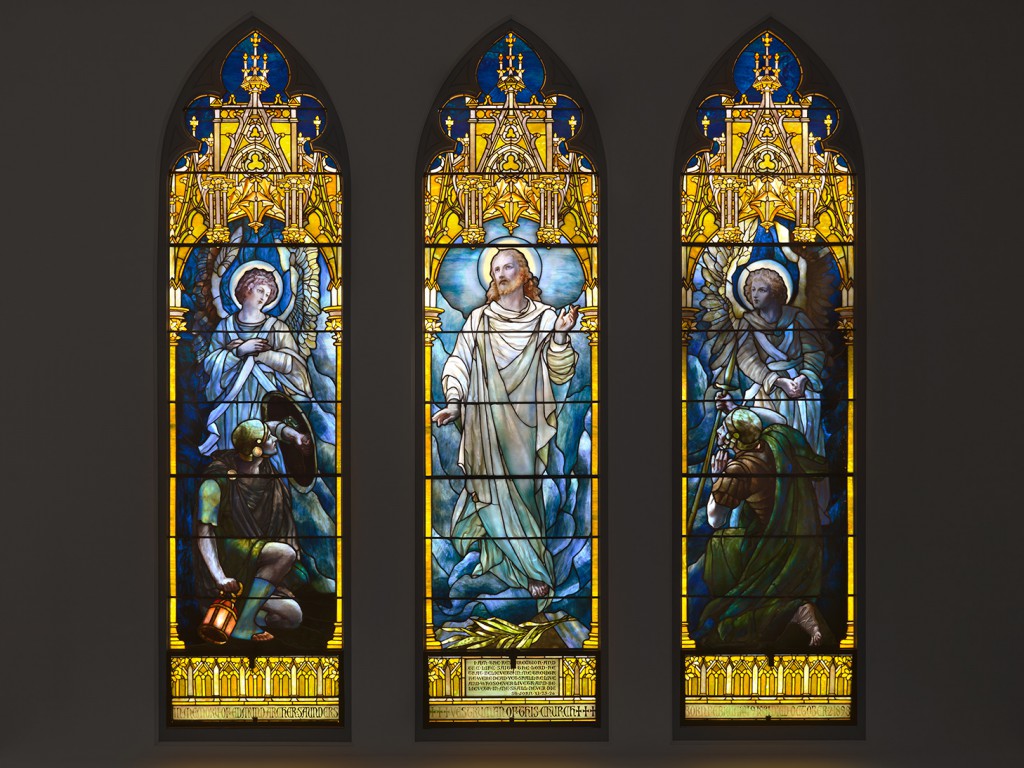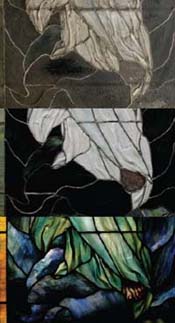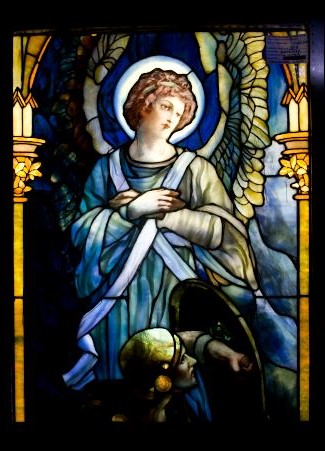The Window’s Story
Designed by Frederick Wilson (1858-1932), the Christ Resurrection windows provide the audience with a dramatic portrayal of the Christian story of Christ rising from the dead: “Thus it is written, and thus it is behooved Christ to suffer, and to rise from the dead the third day (Luke 24:46).” As the quote explains, after Jesus was crucified he rose again three days later; this momentous act is beautifully depicted in a Tiffany leaded-glass window. Wilson was a gifted designer whose specialization was ecclesiastical design. He was “known for the subtle motion he achieved in his graceful figures.” (page 35) At Tiffany Glass & Decorating Company there was a hierarchy for their designers and Wilson was an upper level designer, and later the head of the Ecclesiastical Department, who designed this piece for the All Saints Episcopal Church in Richmond around 1899. They, along with several other windows by Tiffany, were on display at the church’s original location. Around 1958, the church moved to a new building because of its increasing suburban audience. It was originally envisioned to move all of the original glass windows to the new church location, but due to limited space, the Christ Resurrection window and The Blessing of the Children window had to be left behind in the old church. Around the year of 1961, the old church was purchased and condemned to make way for new apartment buildings. Because the old church was being destroyed, the Christ Resurrection and The Blessing of the Children windows were placed in basement storage in the new All Saints Episcopal Church on River Road; here they remained for approximately 30 years.

Christ Resurrection by Frederick Wilson (For All Saints Episcopal Church)
Around the 1990s Scott Taylor of E.S. Taylor Studio visited the Church to implement conservation work on their installed windows. He was perfect for the job considering his specialization was on stained and leaded- glass windows. Taylor was informed of the possibility of more Tiffany windows being in storage and investigated. What he found was the Christ Resurrection window and The Blessing of the Children window. Not only were these leaded-glass windows, but they were also plated windows. He hypothesized that because they were plated-glass windows and used cabochans, or glass medallions, these were most likely Tiffany pieces; a signature on the windows confirmed his hypothesis. The church would later decide to gift the Christ Resurrection windows to the Virginia Museum of Fine Arts and the museum also purchased the Christ Blessing the Children Window.

Layers of the Christ Resurrection Window
After being in a basement for roughly 30 years with a harsh environment of moisture and dirt, the windows were in grave need of cleaning and repair. Taylor found that a lot of the original frames were deteriorating. Considering that these were plated windows he needed to get between the layers in order to see all of the damage, because it was possible for some of the interior panels to have damage while the exterior showed very little. Therefore, when he separated the panels, he did a rubbing (a process in which the leaded glass shapes and overall design is transferred, or recorded, on paper by gently rubbing a pastel, or other shading medium, against paper that is covering the window). A rubbing was completed on each window, in order to get an outline of the overall design. Then, because conservation work requires extensive documentation, he “marked up each section in order to identify [specific details of the work, such as] the number of plates and types of glass in each panel.” When he took them apart he found about 100 shards of glass in three of the pane sections. Not only was there actual breakage but many pieces had undergone devitrification which is irreversible. The parts of the window that he was unable to conserve, he replaced with new pieces of glass and lead. Four pieces in the window are reparations.
The documented rubbings, mentioned previously, would later act as a guide for when Scott Taylor had to put the window back together. But, the job was yet to be complete. With the help of his associate Mary Lu Winger, they removed the grime that had built up through the years of storage. To do this, deionized water and other special cleaners with a neutral pH (a neutral pH means it is neither acidic, nor basic) were used so as not to damage the window.
Now there was a problem with the structure of the window. Not only was the leading used for aesthetic reasons it was also apart of window’s structure and some of it had to be replaced due to deterioration. The whole process of conservation took nearly a year, but upon its completion the Christ Resurrection window was put on display in the American galleries. According to Barry Shifman (VMFA’s Sydney and Francis Lewis Family Curator of Decorative Arts from 1890 to the Present) and as noted in the VMFA article, “Resurrecting a Window,” these windows are “estimated to be part of the 50% of existing Tiffany church windows today.” Therefore, we can safely assume that it is a truly wonderful feat to have these windows on display at the Virginia Museum of Fine Arts.
Here’s a quick video on how to get to the Tiffany windows from the entrance!
Citations:
Frederick Wilson – Tiffany Glass & Decorating Company, Christ Resurrection Window, 1900. Leaded glass, paint. Virginia Museum of Fine Arts.
Pongracz, Patricia C., Elizabeth De Rosa, Lindsy R. Parrott, and Diane C. Write. Louis C. Tiffany and the Art of Devotion. London: D Giles Ltd and New York: Museum of Biblical Art, 2012. Accessed June 06, 2015. http://www.amazon.com/Louis-C-Tiffany-Art-Devotion/dp/1907804021.
“Resurrecting a Window.” Museum Tours. Accessed June 06, 2015. https://vmfa.museum/tours/audio- tours/tiffany-driving-tour/resurrecting-window/.

Exploring Tiffany Windows.
Ready to learn more? Following the links below to explore!